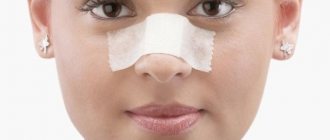Anesthesia for rhinoplasty
The type of anesthesia used for rhinoplasty is determined by the characteristics of the operation and the preference of the surgeon. Three types of anesthesia for rhinoplasty are possible: local anesthesia, a combination of local anesthesia with sedation, and general anesthesia (anesthesia itself).
With local anesthesia, the nose and adjacent areas of the face become numb, the patient hears everything that is happening around him, and sometimes feels something; this may not necessarily be pain, but, for example, a feeling of pressure.
The second type of anesthesia for rhinoplasty involves a combination of local anesthesia with sedation; this is a more comfortable, but riskier option for pain relief for the patient.
The third type of anesthesia for rhinoplasty is general anesthesia. For rhinoplasty, this type of anesthesia is the safest (compared to the second option). In addition, anesthesia during rhinoplasty guarantees the absence of pain and any other sensations, for example, memories of the operation and anesthesia. When performing rhinoplasty under general anesthesia, the anesthesiologist performs tracheal intubation - inserts a special tube into the patient’s airways, which, on the one hand, ensures reliable breathing, and on the other hand, prevents blood from entering the airways and the development of pneumonia. This type of general anesthesia is called endotracheal anesthesia. In addition to ensuring safety, performing endotracheal anesthesia during rhinoplasty creates more comfortable working conditions for the surgeon.
Of course, of all existing types of anesthesia, local anesthesia is the safest option for pain relief during rhinoplasty. If local anesthesia for rhinoplasty is not possible, then endotracheal anesthesia would be the best choice.
It should be noted that when performing rhinoplasty under another type of general anesthesia - intravenous anesthesia - the patient will continue to breathe independently during the operation and his airway will not be protected, which, as with sedation, will pose a risk to his health.
How to do nasal tip plastic surgery
Depending on the amount of necessary changes in the shape of the tip of the nose, its correction can be performed in different ways.
Minimally invasive procedures
They suggest the possibility of changing the contours using injections or correcting the tip of the nose with threads.
These procedures are practically painless, are performed fairly quickly and allow you to correct minor defects, for example, slightly raise, reduce or smooth out the bifurcated tip of the nose.
Rhinoplasty of the nose using special threads provides quite a wide range of possibilities. Correction of the tip of the nose is performed under local anesthesia.
The threads are inserted into the thickness of the skin, fixed and tightened until the desired contour is obtained. All manipulations are performed through punctures, which are completely invisible after 2-3 days.
What to do for the desired result
:
- Avoid the “magic wand syndrome”, since rhinoplasty is not an instant solution, but a labor-intensive operation that requires patience.
- Choose a professional in the field of plastic surgery.
- View photos before and after surgery.
- Select a nose model using computer modeling.
Surgical correction
Minimally invasive methods do not always achieve the desired result and correct significant defects.
In addition, their results are temporary, although they can last for several years.
Surgery to correct the tip of the nose may be necessary after injuries, when the direction of this area has changed, or if there are congenital features of the structure of the nose.
Often, something can only be corrected or changed through rhinoplasty.
In some cases, it is necessary to remove excess tissue to give it a shape, then they are excised and sutured. In others, on the contrary, it is necessary to fill concave areas or hollows. Then the patient's own tissue is most often used - correction of the tip of the nose using an autochondrograft. They can be taken from cartilage located in other parts of the nose.
The operation lasts 2-3 hours. It can be performed under general or local anesthesia. This is decided on a case-by-case basis and depends on many factors. General anesthesia allows the surgeon to perform a more extensive scope of intervention, and the patient to avoid anxiety and discomfort during the operation.
Rhinoplasty under local anesthesia is good because the body suffers less from the effects of the anesthetic and it is possible to avoid side effects that can occur after general anesthesia.
Don't forget about your anatomy!
Surgical correction of the tip of the nose can be performed using open or closed methods. The closed method involves making incisions inside the mucous membrane. Next, the doctor isolates the lower pterygoid cartilages and applies sutures in such a way as to form the desired shape of the tip of the nose.
With this method there are no external stitches, so there is no risk that marks from the operation will remain. However, other problems arise that do not always allow you to achieve the desired result.
The surgeon's options when working with the closed method are limited, and vascular damage is very difficult to control. As a result, the recovery period is prolonged, and the risk of developing hematomas is high.
The technique of rhinoplasty of the tip of the nose, performed using the open method, involves an incision in the area of the bridge, release of the pterygoid cartilages and elimination of excess tissue. The desired shape of the tip of the nose is achieved using sutures. When working with the open method, surgeon errors are minimized.
The choice of method depends on the desired result and the structural features of the tip of the nose; each time it is decided individually. For example, bifurcation correction can be performed using both methods.
With the open method, access and narrowing of the end of the nose is made through an incision in the skin. When closed, additional tissue is introduced through the mucosa into the site of retraction. In this case, the results are very good.
If the tip of the nose is damaged as a result of injury, then the operation is performed using the open method. Often a skin graft is required, which can be taken from the auricle. Nasal injuries are by no means uncommon even among the average person, and not just among athletes.
What determines the choice of method
- Skin thickness
- Nose sizes
- The outline of his back
- Cartilage strength,
- Angle between nose and upper lip.
Of course, the patient’s opinion is taken into account, or more precisely, his desire to have a certain result. However, this alone cannot be used as a guide, and anatomical features must be taken into account, otherwise the operation may lead to completely different results.
Indications for surgery
Surgery may be necessary for congenital abnormalities in the structure of the tip of the nose, or for curvatures resulting from injury or disease.
Indications may include anatomical features that cause aesthetic or physical discomfort to the patient.
The tip of the nose may look to the side, hang down, or be too turned up. All these defects and features can be corrected with rhinoplasty.
Contraindications
Like any surgical intervention, rhinoplasty has a number of limitations, which are determined by the presence of certain diseases in the patient:
- diabetes,
- infections,
- exacerbation of chronic processes,
- oncology,
- blood clotting disorder.
In addition, in women it is necessary to take into account the phase of the menstrual cycle. Pregnancy and the period of breastfeeding are periods when such operations are not performed.
Any person who dreams of having plastic surgery is interested in the issue of anesthesia during surgery.
Less than a decade ago, many Russians were afraid of aesthetic medicine as such, since everyone heard horror stories about anaphylactic shock, coma and other consequences of anesthesia. Unfortunately, we cannot refute such facts. In any country, there are unscrupulous surgeons who do not conduct a detailed study of the medical history and do not even ask the patient about his allergic reactions to medications. Doctor’s negligence can certainly lead to unforeseen and irreversible consequences, so we recommend that you contact only competent specialists with extensive experience and developed skills.
Guess why minimally invasive methods of rejuvenation and correction of certain areas have become so popular today? The fundamental aspect, of course, is gentle anesthesia. However, a full-fledged operation, like, or, simply cannot be performed under local anesthesia and intravenous sedation. Let's look at the types of anesthesia and what pitfalls each of them implies.
Our leader provides all types of aesthetic services, using only high-quality anesthetic drugs. Even after general anesthesia in our clinic, you will wake up alert and calm, you will not be plagued by dizziness, nausea and vomiting. We also guarantee you no side effects after pain relief and take responsibility for your condition during its effect.
Rhinoplasty under local anesthesia
Rhinoplasty is generally performed under general anesthesia. But local is also acceptable. They do not always resort to it, but only in cases where the operation has minimal risks and does not cause difficulties.
Local anesthesia, however, is a last resort. It is inconvenient for both the patient and the surgeon. Even if the operation is painless, a moment of fright cannot be ruled out. You see everything, feel it... It seems to you that it definitely hurts. Your reaction can definitely affect the course of the operation; it can interfere with the surgeon.
Anesthesia or local anesthesia? The video below will tell you which is better:
General anesthesia: scary myths and possible consequences
Modern anesthetics used in the field of aesthetic medicine are low-toxic and therefore rarely cause complications and illnesses after surgery. Our clinic uses only the most modern high-quality drugs that will not cause problems for your health.
What can be the consequences of general anesthesia?
No matter how gentle the drugs are, general anesthesia is a great stress for your body. Therefore, we recommend that you prefer local anesthesia and intravenous sedation whenever possible.
Anaphylactic shock is the main “horror story” of all opponents of plastic surgery. In fact, the risk of such a syndrome does exist, and it depends more on the patient than on the doctor. We strongly recommend that you disclose your history of anaphylactic and allergic reactions to medications during your first conversation with your anesthesiologist in order to avoid such consequences.
Coma. It occurs extremely rarely during plastic surgery and is more often associated with the serious condition of the patient during emergency surgery. If you do not have serious health problems, as well as absolute contraindications to plastic surgery, you are not at risk of this complication. A competent surgeon will always play it safe and study the condition of your body in detail before performing a “voluntary” operation. In addition, any modern clinic is equipped with intensive care and all the necessary means to quickly bring the patient to a healthy state in the event of any emergency.
. “What if I wake up?” A question that torments most future patients of plastic surgery clinics. The fear of waking up during surgery often triumphs over common sense, as a result of which the patient delays seeing a doctor even with the most terrible defects. We would prefer to dispel this myth: modern anesthetics literally guarantee their effect throughout the entire duration of the operation. In addition, the anesthesiologist's task here is not complicated by the patient's serious condition, as can happen with conventional surgery. Therefore, even if the doctor needs additional time to correct your defects, our anesthesiologist can “extend” your sleep without complications for your health.
. “What if I don’t sleep?” During a conversation with an anesthesiologist and studying your tests, you will be selected the optimal anesthesia option, which is guaranteed to have an effect on your consciousness. If for some reason this does not happen, the doctor will cancel the operation.
There's no need to be afraid
There are a whole lot of myths around all types of anesthesia, for example, that a person loses memory after them, his mental abilities decrease, and in general one may not “come out” of anesthesia. In fact, nowadays there are drugs and equipment that can reduce any risks to zero.
In addition, during the operation, the normal course of anesthesia is monitored not only by the surgeon, but also by the anesthesiologist together with an assistant. At the slightest negative reaction on the part of the patient’s body, the necessary assistance will be immediately provided.
When choosing a pain relief method for rhinoplasty, it is highly advisable to listen to the recommendations of your surgeon and anesthesiologist. After all, doctors, seeing the results of your tests and knowing the required volume of surgical intervention, will choose the method that is best suited. A positive attitude and lack of fear of anesthesia will help your body endure both the operation itself and the rehabilitation period as easily as possible.
Source: molod24.ru
Local anesthesia
Most often, rhinoplasty under local anesthesia is performed in cases where the scope of surgical intervention is minimal. Rhinoplasty with this type of anesthesia is also acceptable when general analgesia is not possible due to contraindications or other objective reasons.
Typically, rhinoplasty under local anesthesia is performed if it is planned to correct the tip of the nose or remove a hump. If a more extensive intervention is expected, general anesthesia is preferred. When performing rhinoplasty, infiltration anesthesia is used, that is, the nasal tissues are “impregnated” in layers with an anesthetic drug.
The anesthetic effect of local analgesia is explained by the fact that the drug blocks the transmission of pain impulses in the area where the drug is administered. But at the same time, temperature and tactile sensitivity is preserved, that is, the patient can feel heating of tissues (for example, during coagulation - cauterization, in order to stop bleeding), or pressure.
The most commonly used drugs are:
- Xylocaine;
- Marcain;
- Lidocaine.
Before anesthesia, be sure to perform an allergy test for anesthetic!
It is important to understand that this anesthesia has some contraindications, including:
- Mental disorders.
- Intolerance (individual sensitivity) to local anesthetics.
- State of psychomotor agitation.
- Respiratory disorders.
Also, the reason for refusing local anesthesia in favor of general anesthesia may be the patient’s desire, because often the client is horrified by the possibility of not only feeling, but also partially seeing the doctor’s actions, even if there is no pain.
It should be understood that local anesthesia is always a risk, because there is no guarantee that even an outwardly calm and balanced person who does not have mental disorders will not move in a stressful situation. That is why in 100% of cases, when choosing local anesthesia, the patient is additionally given intravenous injections of fairly strong drugs from a number of sedatives.









